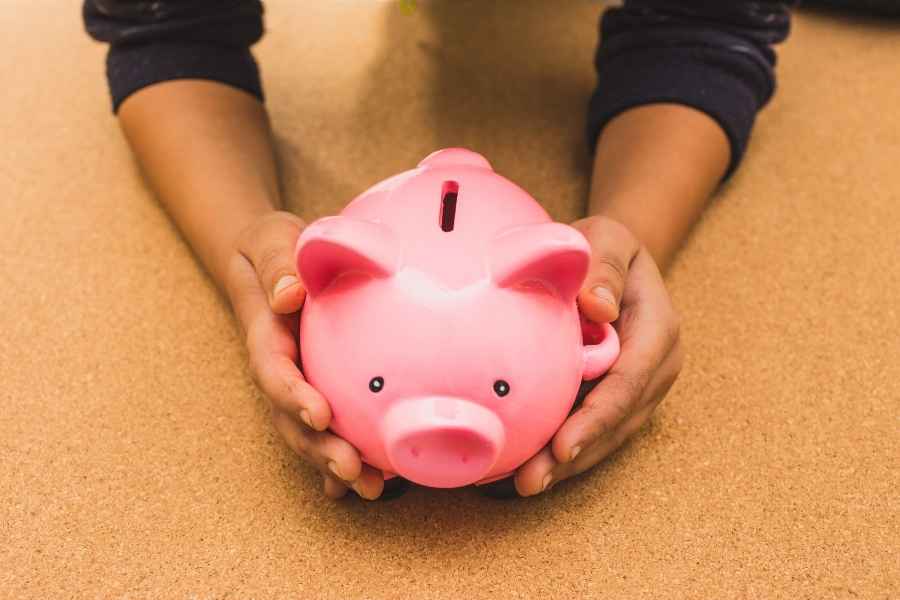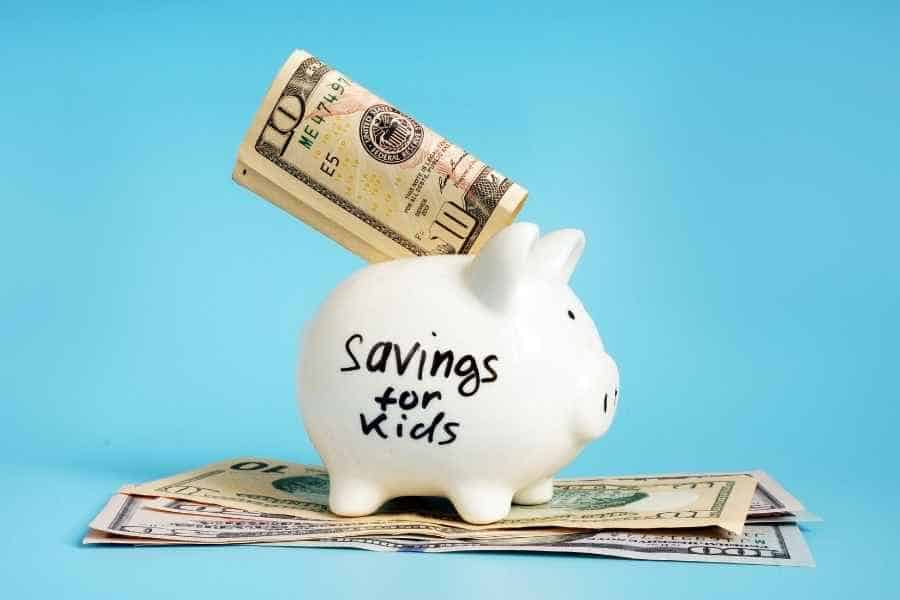Last Updated on September 18, 2022 by Rebecca Lake
Ready to introduce your kids to the concept of budgeting?
Budgeting for kids isn’t that different from budgeting for adults and it can be a great way for kids to learn the basics of personal finance. Teaching kids how to make (and stick to) a budget from a young age can help them develop lifelong financial literacy skills.
Making a monthly budget is an essential skill that’s important to master at any age. Whether you have younger children or teens, here are some of the best ways to encourage budgeting and good money management.
Related post: Importance of Budgeting: Why This Money Skill Matters

LIKE FREE MONEY?
Here are some of my go-to apps for earning extra cash!
Survey Junkie. Earn up to $50 per survey just for sharing your opinions.
Swagbucks. Make money by playing games and watching videos. Join for free and get a $10 bonus when you sign up!
InboxDollars. Take surveys and get paid, no special skills or experience required!
Rakuten. Earn up to 40% cash back at hundreds of retailers, online or in stores. And get $30 for each person you refer, along with a $10 sign up bonus!
CashApp. Need a simple app for sending and receiving money? Get $5 free when you use code ‘VZXRXZN’ to join CashApp.
Benefits of Budgeting for Kids

Kids who learn about money and budgeting earlier tend to do better financially as adults. They also have better relationships as adults, according to a research study from BYU.
The reason?
Financial behaviors are linked with good relationship outcomes, the researchers concluded. Specifically, the study found that if parents do a good job of teaching kids about money, children are more likely to develop healthy behaviors like saving and budgeting.
As kids get older, the good habits they’ve learned allow them to have less stress about money. This, in turn, puts less pressure on romantic relationships.
And that’s pretty important if you’ve ever heard the oft-cited statistic that money is a leading cause of arguments and divorce.
Bottom line? Teaching kids about budgeting can help them be happier, financially stable adults.
Related post: Budgeting Percentages Explained
What Age Should Kids Start Budgeting?

According to the Consumer Financial Protection Bureau, kids are developmentally ready to start learning about budgeting and saving as early as age 5. But the best age for kids to start budgeting is usually when they have their own money to spend or save.
For example, younger kids might get money from doing extra chores at home or earning good grades. Approximately 60% of parents pay kids a weekly or monthly allowance for these types of things.
Meanwhile, older kids in middle school or high school may earn pocket money from allowance, side hustles, a part-time job, a summer job, or even a small business. Kids of all ages can also have money from holiday gifts or birthday gifts.
Teaching a basic skill like budgeting for kids is easier to do when they have a little money of their own to manage.
Why? Because it allows them to take a hands-on approach when applying the financial lessons they’re learning.
And even a very young child can learn the value of money saved from an early age using a piggy bank. That can be a springboard for teaching good financial habits.
How Do You Teach a Child to Budget?

Teaching a child to budget starts with guiding them through what a budget is and why people use it.
So what is a budget?
It’s simply a plan for spending money each month, based on how much money you have coming in. You can call it a budget or a spending plan but it means the same thing.
When discussing budgeting with teens and kids, a good place to start is outlining the different steps for making a budget:
- Step 1: Add up all of your income for the month
- Step 2: Add up total costs or expenses for the month
- Step 3: Subtract your expenses from your income
That’s a simplistic approach but simple may be the best thing when explaining budgeting for kids, especially if they’re younger.
If your kids are older, you can walk them through different budgeting categories and the difference between fixed expenses and variable expenses. You can also explain what discretionary expenses are or dive into different budgeting methods.
For example, some of the top ways to make a budget include:
- 50/30/20 budget method
- 70/20/10 budget rule
- 60 30 10 budget
- 30 30 30 10 budget
- Dave Ramsey budgeting
- Cash envelope budgeting
- Digital envelope system
There’s no right or wrong way to make a budget. The best way to figure out what kind of budget works best is to experiment with different methods.
Relate post: FamZoo Prepaid Debit Card Review: Is Is It the Best Debit Card for Kids?
Tip: Have kids create a sample budget
Having kids make a sample budget can put the mechanics of how a budget works into perspective.
A budgeting worksheet for kids can be a good way to illustrate what a budget looks like on paper. You can also use a simple spreadsheet to demonstrate the concept of budgeting in action.
This doesn’t necessarily require advanced math skills since kids can plug in the numbers and the sheet will do the calculations for them.
Depending on how comfortable you are with the idea, you may share your own budget with your kids. Many financial experts suggest being transparent about your money habits as it can help you to set a good example for budgeting and saving.
And sharing your own budget can also be helpful if you have kids who don’t necessarily grasp the concept of how things like high food prices or rising utility bills affect your family’s bottom line.
You don’t necessarily have to show them your checking account or savings account details. But you can use your budget as part of their financial education to illustrate just how much money things cost in the real world.
Related post: 100+ Budget Categories to Help You Build a Smarter Budget
Budgeting for Kids by Age

The money conversations you have around budgeting should reflect your child’s age and maturity level. Whether you have young kids or older kids, it helps to have a blueprint to follow for budgeting at different ages.
Budgeting for kids (2 to 5 years old)
At this age range, kids may not be earning money of their own yet, depending on whether you have an allowance system or not. But young kids may still get money from the Tooth Fairy or for birthday and holiday gifts.
So if your child gets $10 in birthday money, for instance, you could help them work out a simple budget that lets them spend $5, save $3 and give away $2.
This gets kids in the habit of balancing spending with saving and giving. And you can use a trip to the grocery store or a stop at your local ice cream shop as teachable moments to reinforce the budgeting lessons earned.
For example, say your child wants two treats at the grocery store, which add up to $7 altogether. If they only have $5 to spend you can explain how they don’t have enough money for both, meaning they’ll have to choose one or the other.
Budgeting for kids (6 to 11 years old)
Once kids start to get a little older, you can introduce the idea of setting financial goals. This includes short-term goals and long-term goals.
For example, if your child is a gamer they may want to save up $60 to buy a new video game. That could be a short-term money goal since it’s a relatively small amount of money.
But they may want to aim higher and save $400 toward a brand-new gaming console. This might be a long-term financial goal instead.
Once kids have some specific goals they’re interested in, you can help them create a plan for reaching them. This might include opening a bank account at your bank or credit union where they can keep their savings and breaking down how much they’ll need to save each month.
You can also have a chat about needs and wants and what that means for savings goals. For example, if they want to save $400 for a gaming system, that might mean not spending extra money on anything else for a while.
Teaching kids about delayed gratification from an early age is an important lesson to learn that can serve them well into adulthood.
Related post: How to Live Below Your Means
Budgeting for kids (12 to 15 years old)
Once kids turn 12, that can be a good time to introduce a debit card so they have some control over their money.
Here’s how debit cards for kids typically work:
- You create a parent account and link it to your bank account
- You then add one or more child accounts for each of your kids
- Accounts are linked so you can easily transfer allowance or other money to your kids
- Account controls allow you to set limits on what and where kids can spend
Having a debit card allows kids to make decisions firsthand about where they spend (within parental limits). This can help them with learning how to make smarter choices with their money.
Two of the most popular debit cards for kids are FamZoo and Greenlight. Comparing the features, benefits and costs can help you decide which one is better.
You can also see what options your bank might have for kids’ debit cards.
Budgeting for kids (16 to 18 years old)
At this age, your kids might have a larger goal in sight like saving for a new car, putting money away for college or even starting a business. So they’re likely involving goals that involve more than just lunch money amounts.
If you have college students, they may also be preparing to start using credit. So it could be a good idea to take a deeper dive into personal finance concepts like:
- Credit cards (and credit card bills)
- Credit scores and credit reports
- How a loan or credit card interest rate works
- Health insurance and car insurance
- Taxes (if you haven’t covered that yet)
- Compound interest and how it works for investing
- Real estate and what’s involved in buying a home
You don’t necessarily need to act as your child’s financial planner. But going beyond budgeting can help young people build a stronger foundation for money management once they’re ready to leave home.
Related post: 73 Realistic Ways Kids Can Make Money

Final thoughts on teaching kids how to budget
The key to raising money-smart kids is getting a head start on teaching them financial responsibility. Understanding how a budget works, how to set short-term goals and long-term goals and how to create a savings plan is all a part of that.
Fine-tuning your own spending plan is also important.
Curbing impulse buying, for example, can leave you with more money at the end of each month to save, invest or pay down debt. So setting up bank account alerts or credit card alerts can be a simple way to keep tabs on what you’re spending.
Likewise, comparing your budget from last year to the current year can help you root out wasteful spending. The more good financial decisions you’re making, the easier it is to reach financial freedom a little bit at a time.
Need some help organizing your budget? Check out the best budgeting planners people are using now to take control of their money.
Before you go, be sure to check out my favorite Smart Money Tools for making and saving money!
